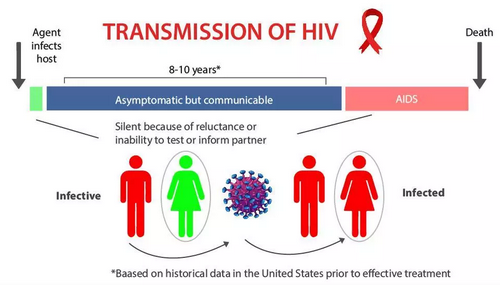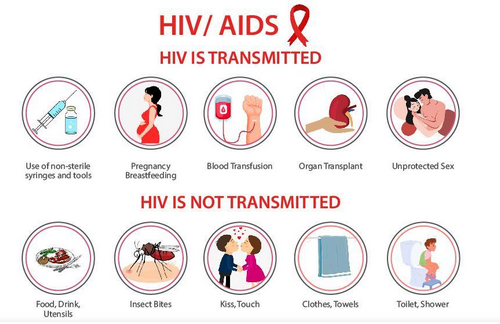AIDS AND HIV: FACTS AND MYTHS ABOUT TRANSMISSION
Time:2023/06/05
Human Immunodeficiency Virus or HIV is a virus that affects and compromises the body’s immune system. An HIV-infected person is easily prone to additional, severe infections and diseases such as cancer. Acquired Immunodeficiency Syndrome or AIDS is the final stage of the 3rd stage of HIV. When HIV goes untreated for a long time, the damaged immune system becomes ineffective, leading to eventual fatality.
Over the years, numerous medical research and advancements have proved to be successful in treating HIV patients, helping them live a whole and healthy life. When administered effectively, new treatments and medications can reduce this virus’s levels in a way that becomes untransmittable.
A quick HIV fact: during the seroconversion period of the infection cycle (2-3 weeks after the infection), the patient’s body starts producing antibodies that can fight the disease and reduce the viral load. At this stage, HIV can be controlled so that it does not culminate into AIDS.
However, despite the developments in modern medicine, at a social level there are a lot of misconceptions and stigma about HIV and AIDS transmission and its treatment, one of the most common being the virus can be transmitted on encountering an HIV-infected person.
Through this article Helvetica Health Care (HHC) aims to debunk some long-standing myths about this disease. As promoters and suppliers of health care services and lab testing products such as high quality seroconversion panels, our experts treat the common misconceptions and break the stereotypes about HIV transmission. We also elucidate some misdirected precepts in medical research and treatment.
Below are some misinformed ideas about HIV and AIDS lingering for decades.

HIV CAN BE TRANSMITTED BY TOUCHING.
The truth about HIV and AIDS is that it can be transmitted only when the bodily fluids from an infected person, such as blood, breast milk, fluid from the anus, semen and vaginal fluid, enter the bloodstream of another person.
HIV cannot be transmitted by
touching or hugging an infected person,
using the same toilets, bathroom facilities or swimming pools,
sharing food, utensils, and telephones with someone who has HIV,
insect bites or infected pets,
receiving blood from an infected person and
through contact with an HIV-infected person’s sweat, saliva or tears.
HIV IS FATAL, AND THERE IS NO WAY TO PREVENT IT.
HIV occurs in three stages. Though this viral infection is still incurable, early diagnosis and treatment can lower viral load to undetectable levels, preventing you from passing HIV on to others and helping people with HIV live longer and healthier lives. It can take up to six months for a person to become undetectable after starting therapy, so it’s critical to test and start treatment as soon as possible.
In terms of prevention, taking Pre-exposure prophylaxis (PrEP) medication and regular use of condoms can protect those who might be at high risk of getting the infection due to unprotected sex or injection drug use. For those who are sexually active in a non-monogamous way, it is recommended to test for sexually transmitted diseases (STD) and HIV regularly. Birth control pills do not help in preventing HIV infection.
HIV DOES NOT AFFECT HETEROSEXUAL PERSONS.
HIV is transmissible from one partner to the other in any sexual relationship because it spreads by the body’s membranes coming in contact with body fluids in the mouth, penis, vagina and rectum. A person can contact HIV through
unprotected anal sex,
unprotected vaginal sex,
sharing of needles, syringes, and other drug equipment,
unsafe tissue transplantation and blood transfusions, and
through birth and breastfeeding.
HIV-positive patients cannot have children without transferring the disease prenatally.
For HIV-positive people, there is a risk that the virus is passed from mother to child. To prevent this, during pregnancy, the mother should begin with antiretroviral (ART) medication, ensure that the birth is by C-section, and not breastfeed the child after birth.
Couples with HIV positive do not need to protect themselves.
On the contrary, HIV+ couples need to protect each other and themselves by ensuring they receive the proper treatment at the right time. Since HIV occurs in stages and given that everyone is of a different constitution, the partners may be at various stages of the disease, and the type of HIV may be different, which could lead to cases of reinfection. Using contraception is advised, especially if both are HIV+.
It is easy to know if someone has HIV.
HIV is an elusive disease because its symptoms appear gradually and, in some cases, not at all. Therefore, getting tested for HIV after having unprotected sex is imperative. In the first stage, the person will likely experience flu-like symptoms like fatigue and fever after exposure to the virus. In the second stage, often, there are no symptoms, and it can last very long. In the third stage – AIDS, the symptoms are often confused with HIV symptoms, although an immune system compromised by AIDS may produce them.
Here are some common misdirected notions in treating HIV and AIDS that are worth considering in understanding the nature of this disease.
All HIV+ patients reach the 3rd stage (AIDS) at the same rate
Research shows that the average duration of HIV to develop into AIDS varies based on the cofactors related to different risk groups:
Mild haemophiliacs (persons who have a genetic bleeding disorder in which the blood does not clot properly): 20 years
Transfusion severe haemophiliacs: 14 years
Old severe haemophiliacs and homosexual men: 10 years
Blood transfusion patients for all ages: 6 years
Organ Transplant patients: 2 years
Babies with perinatal infections: 6 months
【Last : HIV ... 】 【[ Back ]】 【 Next : Why ...】






